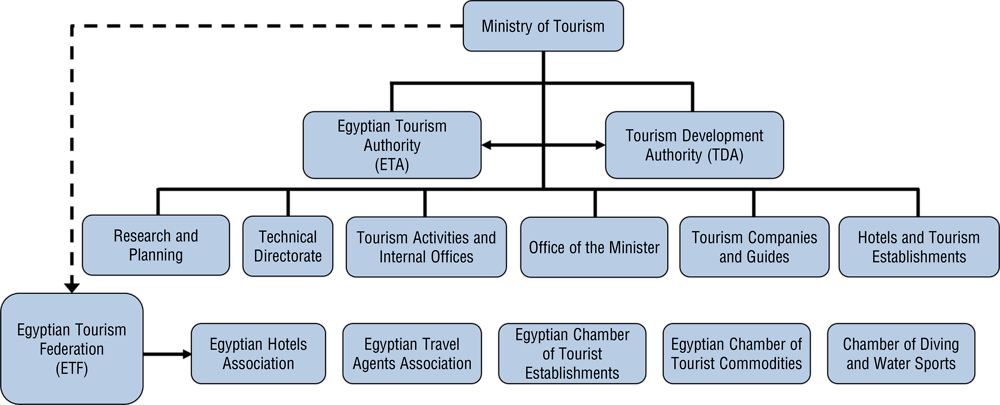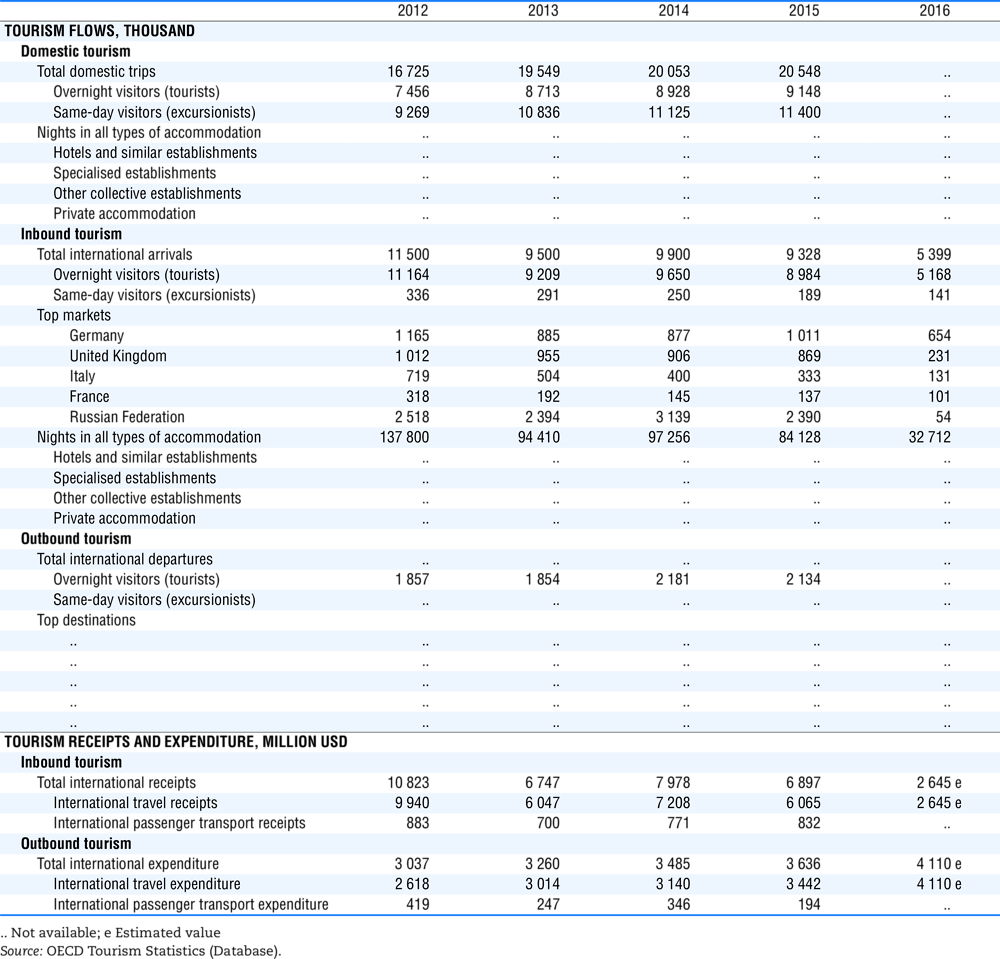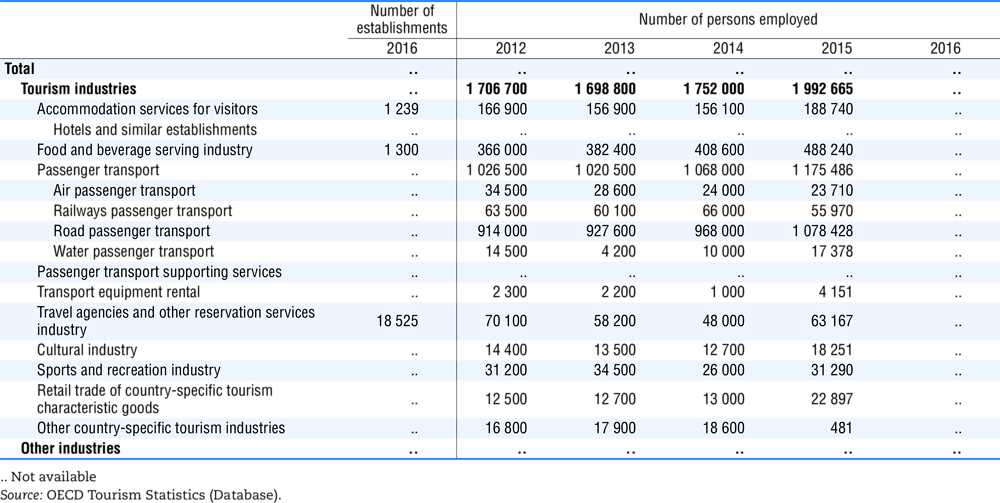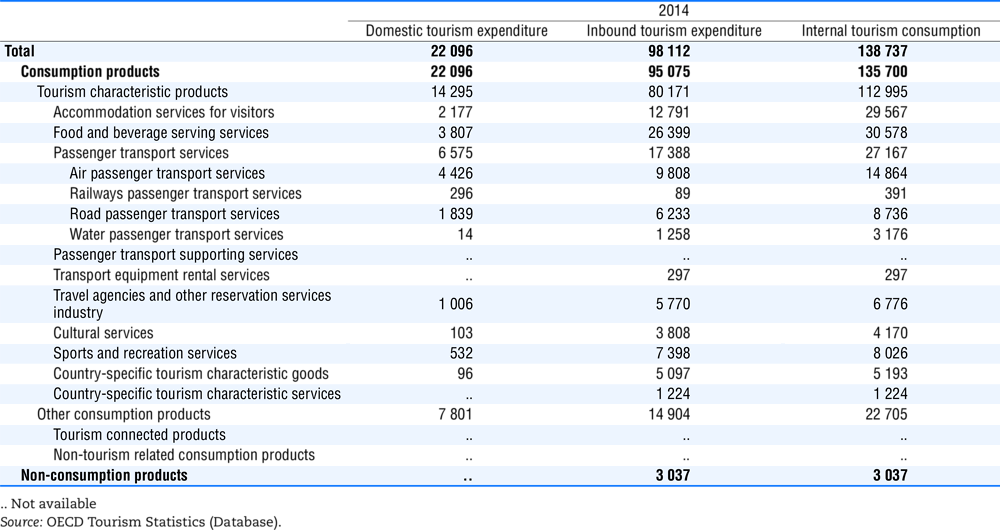Egypt
Tourism in the economy
The tourism industry, involving around 70 sub-sectors, has always been an important economic activity in Egypt. Travel receipts constituted the sixth largest source of foreign currency with international tourists generating a total of USD 2.6 billion in revenue. Tourism contributed (directly and indirectly) 11.3% of Egypt’s GDP in 2015/2016. It accounts for 23% of total services exports.
International tourist arrivals to Egypt reached 5.4 million visitors in 2016 (32.7 million tourist nights). About 12% of inbound tourists are from Germany, 19% from other Western European countries, 15% from Eastern European countries and 36% from Arab countries.
According to Egypt’s Tourism Satellite Account (TSA) for 2014, the labour force working in tourism stood at 1.8 million individuals, representing 6.3% of the total labour force and 7.2% of total employment in Egypt. Around 74% of employees in tourism are full-time with 26% working on a temporary basis or part-time.
Tourism governance and funding
The Ministry of Tourism is responsible for tourism policy and for establishing a coherent legal and regulatory framework for tourism development. Two tourism authorities fall under the Ministry:
-
The Tourism Development Authority works primarily on setting and implementing regulations for tourism projects and investments, by assisting with the provision of land and facilitating access to loans for developing infrastructure projects,
-
The Egyptian Tourism Authority (ETA) is responsible for promoting inbound and domestic tourism. It manages the development and diversification of the tourism product, both regionally and internationally.
The Egyptian Tourism Federation (ETF) is composed of five tourism industry business associations – the Hotels Association, the Travel Agents’ Association, the Chamber of Tourist Establishments, the Chamber of Tourist Commodities and the Chamber of Diving and Water Sports. It works closely with the Ministry of Tourism in areas related to tourism planning, and in managing the Tourism Workforce Skills Development Project. By law, the ETF’s views are considered before any new legislative measures are taken.
The Ministry recognises the need to support coordination with other ministries and institutions for effective tourism policy and is working to improve co-operation among all relevant stakeholders. To assist in this process, the Ministry has adopted a concept of decentralisation in tourism to ease communication between the government and the private sector, implemented effective structures for the management and development of tourism activity, adapted laws and regulations to attract investment, maintained the stability of private sector participation (represented by the ETF and its five chambers) by strengthening relations with tourism clusters such as investor associations and tourism committees in the chambers of commerce, and sought to provide regular, accurate and transparent data.
The Supreme Council for Tourism helps to fast track progress by removing barriers. It involves eleven ministries and the ETF, and is chaired by the President.
The general budget for tourism promotion is around USD 67 million which is directed towards external activities including: launching a new branding campaign over the next three years for global marketing, setting up interactive advertising in touristic sites, enhancing public relations and optimising search engines. These activities are managed by the ETA and financed by the Tourism Fund Unit at the Ministry. The Accountability State Authority (ASA), an external government agency, monitors and evaluates the fund expenditure to ensure a transparent process.

Source: OECD, adapted from Ministry of Tourism, 2018.
Tourism policies and programmes
Egypt’s national strategy considers tourism as an important national industry and seeks to create a suitable environment to support tourism. Tourism faces many challenges and new policies have to be set to enhance a competitive, sustainable and inclusive tourism industry. Such challenges include:
-
Infrastructure: restrictions on charter airlines, the railways etc.,
-
Workforce: qualification gaps, the need for “on the job” training, technology skills and certified instructors, technical education and vocational training, and quality of service,
-
Complex legislative and licensing frameworks: the new Tourism Law is yet to be implemented,
-
Safety and security: hygiene, traffic safety, emergency systems, hotel standards, public security and tourism awareness,
-
Marketing and promotion: branding and public relations,
-
Sustainability issues: energy efficiency, the use of solar and renewable energy sources, water consumption, biodiversity, solid/liquid waste and carbon emissions.
The sustainable tourism strategy is currently being revised with new targets for 2030. The priorities are to increase value, to achieve high and sustainable economic growth, alleviate poverty, address income disparities, create productive jobs and increase gender equality. The strategic targets are to:
-
Attract 20 million international arrivals,
-
Raise the average tourist expenditure per night by 50%,
-
Increase Egypt’s share of world tourism to 1.5%,
-
Double Egypt’s share of Arab tourism,
-
Raise tourism revenues to USD 20 billion,
-
Attract USD 10 billion of new foreign direct investment in tourism.
The strategy seeks to address the challenges and achieve its targets through landmark reforms and investments. Initiatives include:
-
Institutional change: Establishing the Tourism Development Authority and Ministry of Tourism as a one-stop-shop for licenses and permits, developing an intranet system linking hotels, chambers and the Ministry, and establishing an advisory committee of experts headed by the minister.
-
Connectivity: Providing a new entry regime for many source markets with an E-visa system and support for the private sector when establishing new routes or enhancing frequency for travel.
-
Marketing and promotion: Presenting products and services in strategic markets using innovative and smart techniques including, a new marketing website with 14 languages, an online campaign in traditional markets and China and India, better management of social media, working with bloggers, a new cultural tourism commercial, and promotion of the new VAT refund system. These activities will support traditional promotion and marketing tools.
-
Investment: Developing and diversifying tourism products and services, responding to customer needs and trends, building high quality visitor experiences, developing a strong sense of place and style for Egypt and for the five internal destinations.
-
Sustainability: Establishing eco-principles and a “green” tourism unit, heritage preservation, a “Green Star Hotel” programme monitoring the transformation of hotels to environmentally friendly management and efforts to enhance environmental awareness in the sector.
-
Workforce: Promoting a National Skill Standards Project, a culinary training centre, enhanced capacities in tourism establishments, and an accreditation and certification system.
Egypt will apply the principles of social inclusion in its approach to tourism. It will target the citizens and communities of Egypt as primary beneficiaries by providing opportunities for employment and income generation, by positively contributing to government programs, by supporting quality of life and environmental excellence and by developing communities and society. Investments should cover skill development and training to enhance human resource development and capacity building across the sector.



